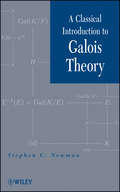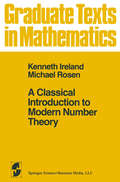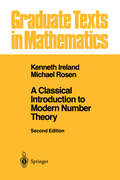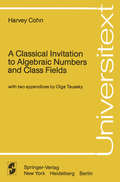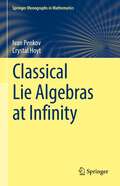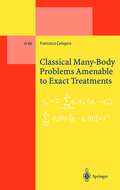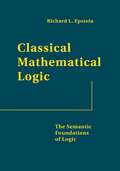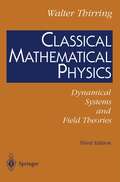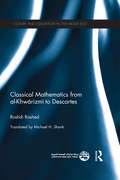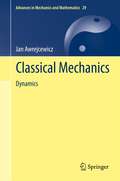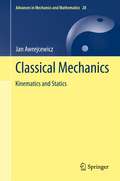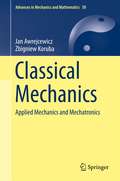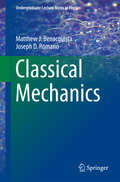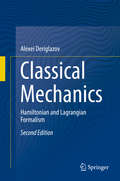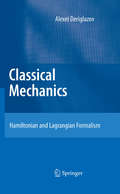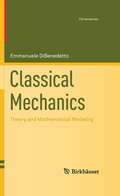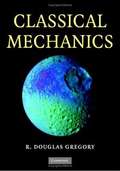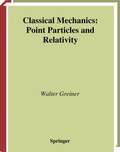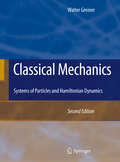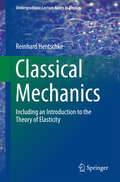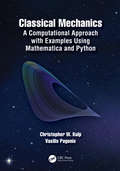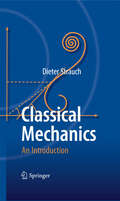- Table View
- List View
A Classical Introduction to Galois Theory
by Stephen C. NewmanExplore the foundations and modern applications of Galois theory Galois theory is widely regarded as one of the most elegant areas of mathematics. A Classical Introduction to Galois Theory develops the topic from a historical perspective, with an emphasis on the solvability of polynomials by radicals. The book provides a gradual transition from the computational methods typical of early literature on the subject to the more abstract approach that characterizes most contemporary expositions. The author provides an easily-accessible presentation of fundamental notions such as roots of unity, minimal polynomials, primitive elements, radical extensions, fixed fields, groups of automorphisms, and solvable series. As a result, their role in modern treatments of Galois theory is clearly illuminated for readers. Classical theorems by Abel, Galois, Gauss, Kronecker, Lagrange, and Ruffini are presented, and the power of Galois theory as both a theoretical and computational tool is illustrated through: A study of the solvability of polynomials of prime degree Development of the theory of periods of roots of unity Derivation of the classical formulas for solving general quadratic, cubic, and quartic polynomials by radicals Throughout the book, key theorems are proved in two ways, once using a classical approach and then again utilizing modern methods. Numerous worked examples showcase the discussed techniques, and background material on groups and fields is provided, supplying readers with a self-contained discussion of the topic. A Classical Introduction to Galois Theory is an excellent resource for courses on abstract algebra at the upper-undergraduate level. The book is also appealing to anyone interested in understanding the origins of Galois theory, why it was created, and how it has evolved into the discipline it is today.
A Classical Introduction to Modern Number Theory (Graduate Texts in Mathematics #84)
by K. Ireland M. RosenThis book is a revised and greatly expanded version of our book Elements of Number Theory published in 1972. As with the first book the primary audience we envisage consists of upper level undergraduate mathematics majors and graduate students. We have assumed some familiarity with the material in a standard undergraduate course in abstract algebra. A large portion of Chapters 1-11 can be read even without such background with the aid of a small amount of supplementary reading. The later chapters assume some knowledge of Galois theory, and in Chapters 16 and 18 an acquaintance with the theory of complex variables is necessary. Number theory is an ancient subject and its content is vast. Any intro ductory book must, of necessity, make a very limited selection from the fascinat ing array of possible topics. Our focus is on topics which point in the direction of algebraic number theory and arithmetic algebraic geometry. By a careful selection of subject matter we have found it possible to exposit some rather advanced material without requiring very much in the way oftechnical background. Most of this material is classical in the sense that is was dis covered during the nineteenth century and earlier, but it is also modern because it is intimately related to important research going on at the present time.
A Classical Introduction to Modern Number Theory (Graduate Texts in Mathematics #84)
by Kenneth Ireland Michael RosenThis well-developed, accessible text details the historical development of the subject throughout. It also provides wide-ranging coverage of significant results with comparatively elementary proofs, some of them new. This second edition contains two new chapters that provide a complete proof of the Mordel-Weil theorem for elliptic curves over the rational numbers and an overview of recent progress on the arithmetic of elliptic curves.
A Classical Invitation to Algebraic Numbers and Class Fields (Universitext)
by Harvey Cohn"Artin's 1932 Göttingen Lectures on Class Field Theory" and "Connections between Algebrac Number Theory and Integral Matrices"
Classical Lie Algebras at Infinity (Springer Monographs in Mathematics)
by Ivan Penkov Crystal HoytOriginating from graduate topics courses given by the first author, this book functions as a unique text-monograph hybrid that bridges a traditional graduate course to research level representation theory. The exposition includes an introduction to the subject, some highlights of the theory and recent results in the field, and is therefore appropriate for advanced graduate students entering the field as well as research mathematicians wishing to expand their knowledge. The mathematical background required varies from chapter to chapter, but a standard course on Lie algebras and their representations, along with some knowledge of homological algebra, is necessary. Basic algebraic geometry and sheaf cohomology are needed for Chapter 10. Exercises of various levels of difficulty are interlaced throughout the text to add depth to topical comprehension.The unifying theme of this book is the structure and representation theory of infinite-dimensional locally reductive Lie algebras and superalgebras. Chapters 1-6 are foundational; each of the last 4 chapters presents a self-contained study of a specialized topic within the larger field. Lie superalgebras and flag supermanifolds are discussed in Chapters 3, 7, and 10, and may be skipped by the reader.
Classical Many-Body Problems Amenable to Exact Treatments: (Solvable and/or Integrable and/or Linearizable...) in One-, Two- and Three-Dimensional Space (Lecture Notes in Physics Monographs #66)
by Francesco CalogeroThis book focuses treatable This class on exactly many' body problems. does not include most We are therefore reminded "of physical problems. the of the man home late at after an alcoholic who, story returning night the for his under he was a knew, evening, scanning ground key lamppost; be that he had it somewhere but under the to sure, dropped else, only Yet was there to conduct a searcW' . light lamppost enough proper we feel the interest for such models is nowadays sufficiently widespread because of their their mathematical relevance and their multi beauty, farious that need be made for no our apologies applicative potential choice. In whoever undertakes to read this book will know from any case, its title what she is in for! Yet this title a of it some may require explanations: gloss (including its extended inside front follows. version, see cover) and nonrelativistic "Classical" we mean nonquantal (although By consider the which indeed some are Ruijsenaars Schneider models, treated in this relativistic versions as known, nonre book, of, previously lativistic is focussed see our on models; below): presentation mainly of whose time evolution is determined many body point particles systems Newtonian of motion to by equations (acceleration proportional force).
Classical Mathematical Logic: The Semantic Foundations of Logic
by Richard L. Epstein Leslaw W. SzczerbaIn Classical Mathematical Logic, Richard L. Epstein relates the systems of mathematical logic to their original motivations to formalize reasoning in mathematics. The book also shows how mathematical logic can be used to formalize particular systems of mathematics. It sets out the formalization not only of arithmetic, but also of group theory, field theory, and linear orderings. These lead to the formalization of the real numbers and Euclidean plane geometry. The scope and limitations of modern logic are made clear in these formalizations. The book provides detailed explanations of all proofs and the insights behind the proofs, as well as detailed and nontrivial examples and problems. The book has more than 550 exercises. It can be used in advanced undergraduate or graduate courses and for self-study and reference. Classical Mathematical Logic presents a unified treatment of material that until now has been available only by consulting many different books and research articles, written with various notation systems and axiomatizations.
Classical Mathematical Logic: The Semantic Foundations of Logic (PDF)
by Richard L. Epstein Leslaw W. SzczerbaIn Classical Mathematical Logic, Richard L. Epstein relates the systems of mathematical logic to their original motivations to formalize reasoning in mathematics. The book also shows how mathematical logic can be used to formalize particular systems of mathematics. It sets out the formalization not only of arithmetic, but also of group theory, field theory, and linear orderings. These lead to the formalization of the real numbers and Euclidean plane geometry. The scope and limitations of modern logic are made clear in these formalizations. The book provides detailed explanations of all proofs and the insights behind the proofs, as well as detailed and nontrivial examples and problems. The book has more than 550 exercises. It can be used in advanced undergraduate or graduate courses and for self-study and reference. Classical Mathematical Logic presents a unified treatment of material that until now has been available only by consulting many different books and research articles, written with various notation systems and axiomatizations.
Classical Mathematical Physics: Dynamical Systems and Field Theories
by Walter ThirringThis book combines the enlarged and corrected editions of both volumes on classical physics stemming from Thirrings famous course. The treatment of classical dynamical systems uses analysis on manifolds to provide the mathematical setting for discussions of Hamiltonian systems, canonical transformations, constants of motion, and perturbation theory. Problems discussed include: nonrelativistic motion of particles and systems, relativistic motion in electromagnetic and gravitational fields, and the structure of black holes. The treatment of classical fields uses the language of differential geometry, treating both Maxwells and Einsteins equations in a compact and clear fashion. The book includes discussions of the electromagnetic field due to known charge distributions and in the presence of conductors, as well as a new section on gauge theories. It discusses the solutions of the Einstein equations for maximally symmetric spaces and spaces with maximally symmetric submanifolds, and concludes by applying these results to the life and death of stars. Numerous examples and accompanying remarks make this an ideal textbook.
Classical Mathematics from Al-Khwarizmi to Descartes (Culture and Civilization in the Middle East)
by Roshdi RashedThis book follows the development of classical mathematics and the relation between work done in the Arab and Islamic worlds and that undertaken by the likes of Descartes and Fermat. ‘Early modern,’ mathematics is a term widely used to refer to the mathematics which developed in the West during the sixteenth and seventeenth century. For many historians and philosophers this is the watershed which marks a radical departure from ‘classical mathematics,’ to more modern mathematics; heralding the arrival of algebra, geometrical algebra, and the mathematics of the continuous. In this book, Roshdi Rashed demonstrates that ‘early modern,’ mathematics is actually far more composite than previously assumed, with each branch having different traceable origins which span the millennium. Going back to the beginning of these parts, the aim of this book is to identify the concepts and practices of key figures in their development, thereby presenting a fuller reality of these mathematics. This book will be of interest to students and scholars specialising in Islamic science and mathematics, as well as to those with an interest in the more general history of science and mathematics and the transmission of ideas and culture.
Classical Mathematics from Al-Khwarizmi to Descartes (Culture and Civilization in the Middle East)
by Roshdi RashedThis book follows the development of classical mathematics and the relation between work done in the Arab and Islamic worlds and that undertaken by the likes of Descartes and Fermat. ‘Early modern,’ mathematics is a term widely used to refer to the mathematics which developed in the West during the sixteenth and seventeenth century. For many historians and philosophers this is the watershed which marks a radical departure from ‘classical mathematics,’ to more modern mathematics; heralding the arrival of algebra, geometrical algebra, and the mathematics of the continuous. In this book, Roshdi Rashed demonstrates that ‘early modern,’ mathematics is actually far more composite than previously assumed, with each branch having different traceable origins which span the millennium. Going back to the beginning of these parts, the aim of this book is to identify the concepts and practices of key figures in their development, thereby presenting a fuller reality of these mathematics. This book will be of interest to students and scholars specialising in Islamic science and mathematics, as well as to those with an interest in the more general history of science and mathematics and the transmission of ideas and culture.
Classical Mechanics: Dynamics (Advances in Mechanics and Mathematics #29)
by Jan AwrejcewiczThis is the second volume of three books devoted to Mechanics. In this book, dynamical and advanced mechanics problems are stated, illustrated, and discussed, including a few novel concepts in comparison to standard text books and monographs. Apart from being addressed to a wide spectrum of graduate students, postgraduate students, researchers, and teachers from the fields of mechanical and civil engineering, this volume is also intended to be used as a self-contained material for applied mathematicians and physical scientists and researchers.
Classical Mechanics: Kinematics and Statics (Advances in Mechanics and Mathematics #28)
by Jan AwrejcewiczThis is the first volume of three, devoted to Mechanics. This book contains classical mechanics problems including kinematics and statics. It is recommended as a supplementary textbook for undergraduate and graduate students from mechanical and civil engineering, as well as for physical scientists and engineers. It contains a basic introduction to classical mechanics, including fundamental principles, statics, and the geometry of masses, as well as thorough discussion on kinematics.
Classical Mechanics: Applied Mechanics and Mechatronics (Advances in Mechanics and Mathematics #30)
by Jan Awrejcewicz Zbigniew KorubaThis is the last book of three devoted to Mechanics, and uses the theoretical background presented in Classical Mechanics: Kinematics and Statics and Classical Mechanics: Dynamics. It focuses on exhibiting a unique approach, rooted in the classical mechanics, to study mechanical and electromagnetic processes occurring in Mechatronics. Contrary to the majority of the books devoted to Applied Mechanics, this volume places a particular emphasis on theory, modeling, analysis, and control of gyroscopic devices, including the military applications. This volume provides practicing mechanical/mechatronic engineers and designers, researchers, graduate and postgraduate students with a knowledge of mechanics focused directly on advanced applications.
Classical Mechanics (Undergraduate Lecture Notes in Physics)
by Matthew J. Benacquista Joseph D. RomanoThis textbook provides an introduction to classical mechanics at a level intermediate between the typical undergraduate and advanced graduate level. This text describes the background and tools for use in the fields of modern physics, such as quantum mechanics, astrophysics, particle physics, and relativity. Students who have had basic undergraduate classical mechanics or who have a good understanding of the mathematical methods of physics will benefit from this book.
Classical Mechanics: Hamiltonian and Lagrangian Formalism
by Alexei DeriglazovThe revised edition of this advanced textbook provides the reader with a solid grounding in the formalism of classical mechanics, underlying a number of powerful mathematical methods that are widely used in modern theoretical and mathematical physics. It reviews the fundamentals of Lagrangian and Hamiltonian mechanics, and goes on to cover related topics such as canonical transformations, integral invariants, potential motion in geometric setting, symmetries, the Noether theorem and systems with constraints. While in some cases the formalism is developed beyond the traditional level adopted in the standard textbooks on classical mechanics, only elementary mathematical methods are used in the exposition of the material.New material for the revised edition includes additional sections on the Euler-Lagrange equation, the Cartan two-form in Lagrangian theory, and Newtonian equations of motion in context of general relativity. Also new for this edition is the inclusion of problem sets and solutions to aid in the understanding of the material presented.The mathematical constructions involved are explicitly described and explained, so the book is a good starting point for the student new to this field. Where possible, intuitive motivations are replaced by explicit proofs and direct computations, preserving the level of rigor that makes the book useful for more advanced students intending to work in one of the branches of the vast field of theoretical physics. To illustrate how classical-mechanics formalism works in other branches of theoretical physics, examples related to electrodynamics, as well as to relativistic and quantum mechanics, are included.
Classical Mechanics: Hamiltonian and Lagrangian Formalism
by Alexei DeriglazovFormalism of classical mechanics underlies a number of powerful mathematical methods that are widely used in theoretical and mathematical physics. This book considers the basics facts of Lagrangian and Hamiltonian mechanics, as well as related topics, such as canonical transformations, integral invariants, potential motion in geometric setting, symmetries, the Noether theorem and systems with constraints. While in some cases the formalism is developed beyond the traditional level adopted in the standard textbooks on classical mechanics, only elementary mathematical methods are used in the exposition of the material. The mathematical constructions involved are explicitly described and explained, so the book can be a good starting point for the undergraduate student new to this field. At the same time and where possible, intuitive motivations are replaced by explicit proofs and direct computations, preserving the level of rigor that makes the book useful for the graduate students intending to work in one of the branches of the vast field of theoretical physics. To illustrate how classical-mechanics formalism works in other branches of theoretical physics, examples related to electrodynamics, as well as to relativistic and quantum mechanics, are included.
Classical Mechanics: Theory and Mathematical Modeling (Cornerstones)
by Emmanuele DiBenedetto* Offers a rigorous mathematical treatment of mechanics as a text or reference * Revisits beautiful classical material, including gyroscopes, precessions, spinning tops, effects of rotation of the Earth on gravity motions, and variational principles * Employs mathematics not only as a "unifying" language, but also to exemplify its role as a catalyst behind new concepts and discoveries
Classical Mechanics: An Undergraduate Text (PDF)
by R. Douglas GregoryGregory's Classical Mechanics is a major new textbook for undergraduates in mathematics and physics. It is a thorough, self-contained and highly readable account of a subject many students find difficult. The author's clear and systematic style promotes a good understanding of the subject: each concept is motivated and illustrated by worked examples, while problem sets provide plenty of practice for understanding and technique. Computer assisted problems, some suitable for projects, are also included. The book is structured to make learning the subject easy; there is a natural progression from core topics to more advanced ones and hard topics are treated with particular care. A theme of the book is the importance of conservation principles. These appear first in vectorial mechanics where they are proved and applied to problem solving. They reappear in analytical mechanics, where they are shown to be related to symmetries of the Lagrangian, culminating in Noether's theorem.
Classical Mechanics: Point Particles and Relativity (Classical Theoretical Physics)
by Walter GreinerIntended for advanced undergraduates and beginning graduate students, this text is based on the highly successful course given by Walter Greiner at the University of Frankfurt, Germany. The two volumes on classical mechanics provide not only a complete survey of the topic but also an enormous number of worked examples and problems to show students clearly how to apply the abstract principles to realistic problems.
Classical Mechanics: Including an Introduction to the Theory of Elasticity (Undergraduate Lecture Notes in Physics)
by Reinhard HentschkeThis textbook teaches classical mechanics as one of the foundations of physics. It describes the mechanical stability and motion in physical systems ranging from the molecular to the galactic scale. Aside from the standard topics of mechanics in the physics curriculum, this book includes an introduction to the theory of elasticity and its use in selected modern engineering applications, e.g. dynamic mechanical analysis of viscoelastic materials. The text also covers many aspects of numerical mechanics, ranging from the solution of ordinary differential equations, including molecular dynamics simulation of many particle systems, to the finite element method. Attendant Mathematica programs or parts thereof are provided in conjunction with selected examples. Numerous links allow the reader to connect to related subjects and research topics. Among others this includes statistical mechanics (separate chapter), quantum mechanics, space flight, galactic dynamics, friction, and vibration spectroscopy. An introductory chapter compiles all essential mathematical tools, ranging from coordinates to complex numbers. Completely solved problems and examples facilitate a thorough understanding of the material.
Classical Mechanics: A Computational Approach with Examples Using Mathematica and Python
by Christopher W. Kulp Vasilis PagonisClassical Mechanics: A Computational Approach with Examples using Python and Mathematica provides a unique, contemporary introduction to classical mechanics, with a focus on computational methods. In addition to providing clear and thorough coverage of key topics, this textbook includes integrated instructions and treatments of computation. Full of pedagogy, it contains both analytical and computational example problems within the body of each chapter. The example problems teach readers both analytical methods and how to use computer algebra systems and computer programming to solve problems in classical mechanics. End-of-chapter problems allow students to hone their skills in problem solving with and without the use of a computer. The methods presented in this book can then be used by students when solving problems in other fields both within and outside of physics. It is an ideal textbook for undergraduate students in physics, mathematics, and engineering studying classical mechanics. Features: Gives readers the "big picture" of classical mechanics and the importance of computation in the solution of problems in physics Numerous example problems using both analytical and computational methods, as well as explanations as to how and why specific techniques were used Online resources containing specific example codes to help students learn computational methods and write their own algorithms A solutions manual is available via the Routledge Instructor Hub and extra code is available via the Support Material tab
Classical Mechanics: A Computational Approach with Examples Using Mathematica and Python
by Christopher W. Kulp Vasilis PagonisClassical Mechanics: A Computational Approach with Examples using Python and Mathematica provides a unique, contemporary introduction to classical mechanics, with a focus on computational methods. In addition to providing clear and thorough coverage of key topics, this textbook includes integrated instructions and treatments of computation. Full of pedagogy, it contains both analytical and computational example problems within the body of each chapter. The example problems teach readers both analytical methods and how to use computer algebra systems and computer programming to solve problems in classical mechanics. End-of-chapter problems allow students to hone their skills in problem solving with and without the use of a computer. The methods presented in this book can then be used by students when solving problems in other fields both within and outside of physics. It is an ideal textbook for undergraduate students in physics, mathematics, and engineering studying classical mechanics. Features: Gives readers the "big picture" of classical mechanics and the importance of computation in the solution of problems in physics Numerous example problems using both analytical and computational methods, as well as explanations as to how and why specific techniques were used Online resources containing specific example codes to help students learn computational methods and write their own algorithms A solutions manual is available via the Routledge Instructor Hub and extra code is available via the Support Material tab
Classical Mechanics: An Introduction
by Dieter StrauchThis upper-level undergraduate and beginning graduate textbook primarily covers the theory and application of Newtonian and Lagrangian, but also of Hamiltonian mechanics. In addition, included are elements of continuum mechanics and the accompanying classical field theory, wherein four-vector notation is introduced without explicit reference to special relativity. The author's writing style attempts to ease students through the primary and secondary results, thus building a solid foundation for understanding applications. Numerous examples illustrate the material and often present alternative approaches to the final results.
